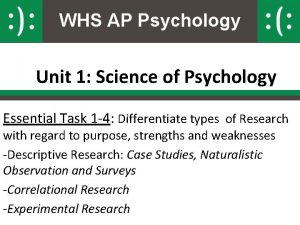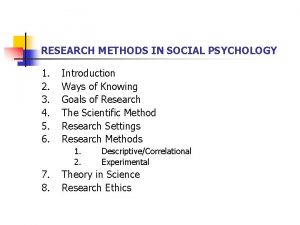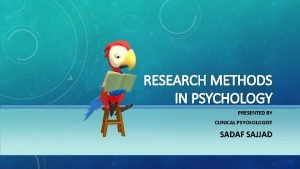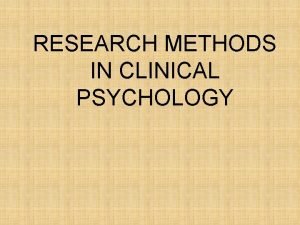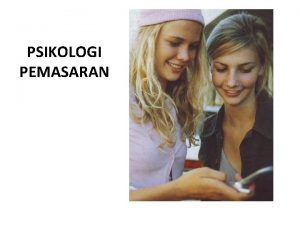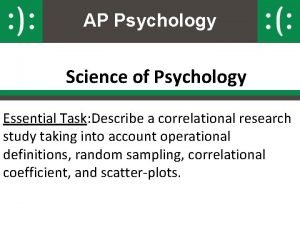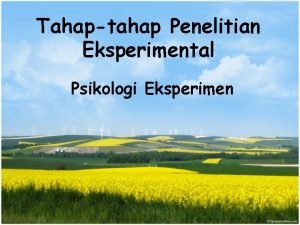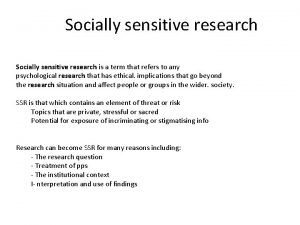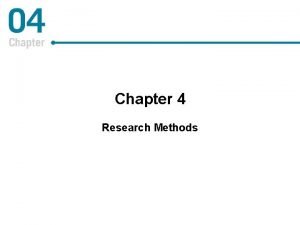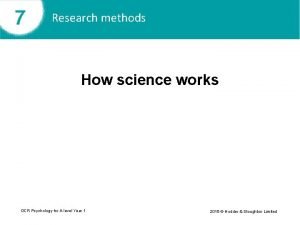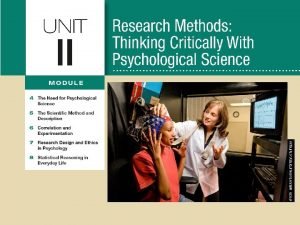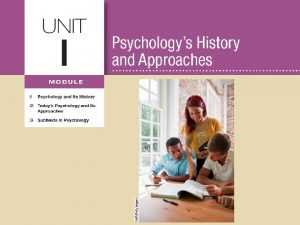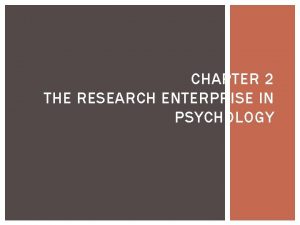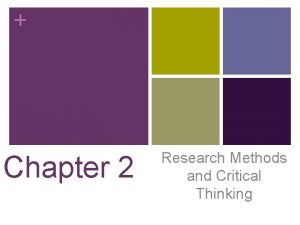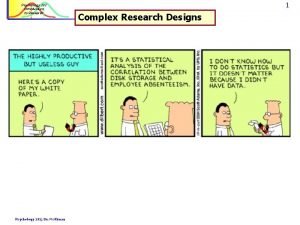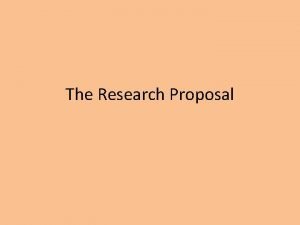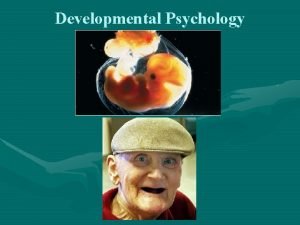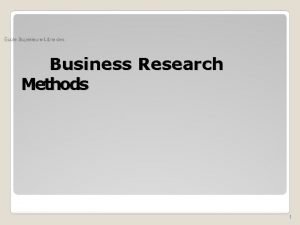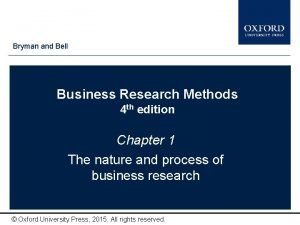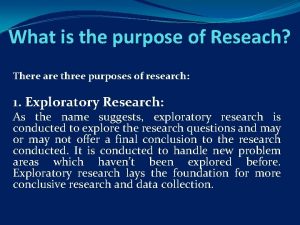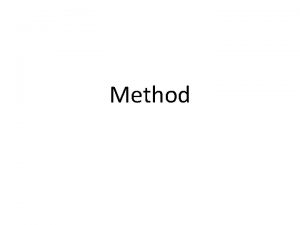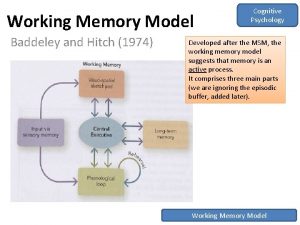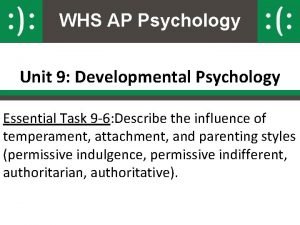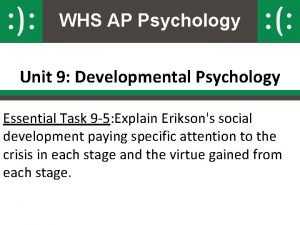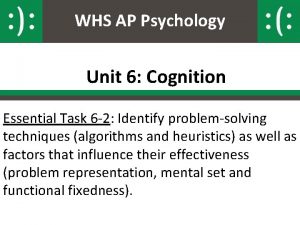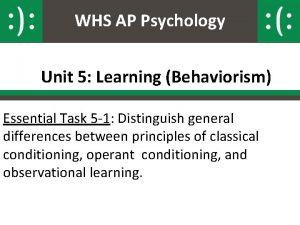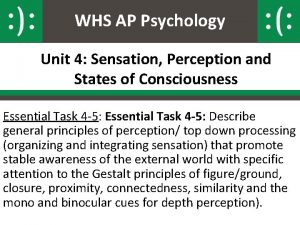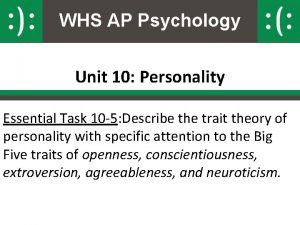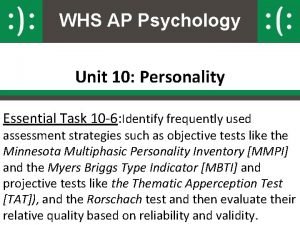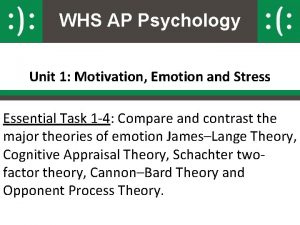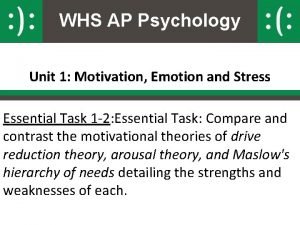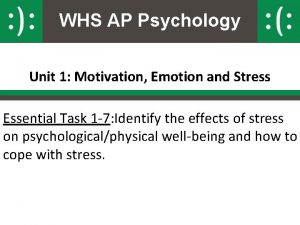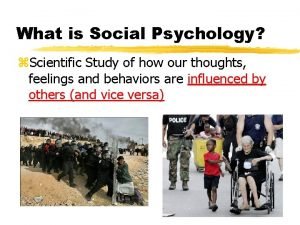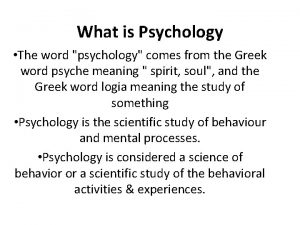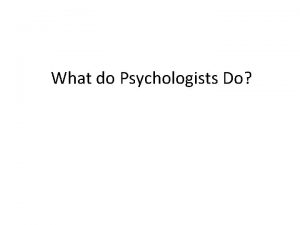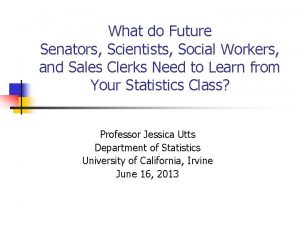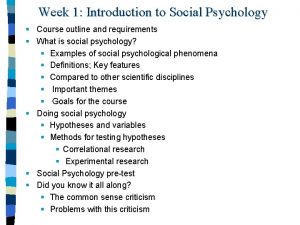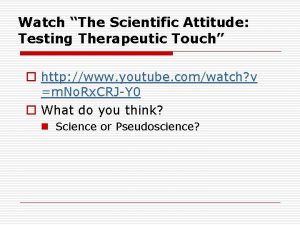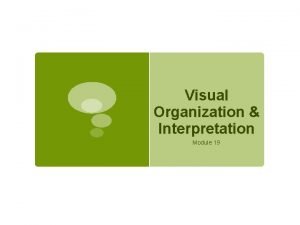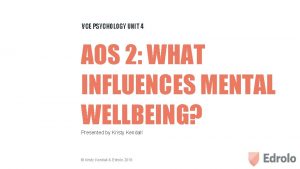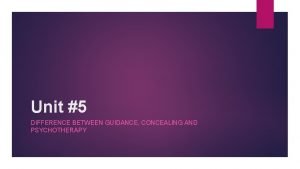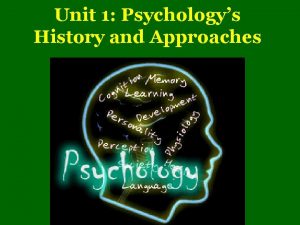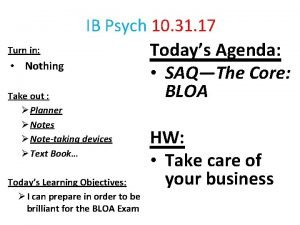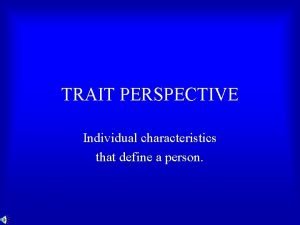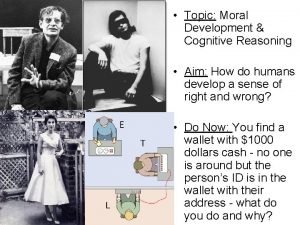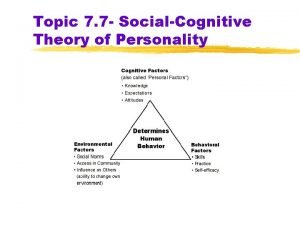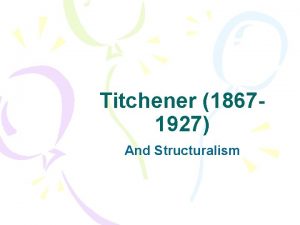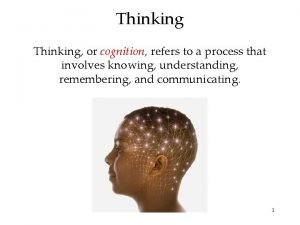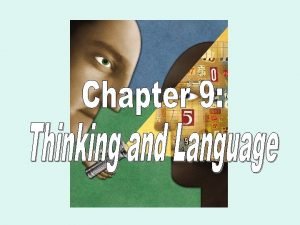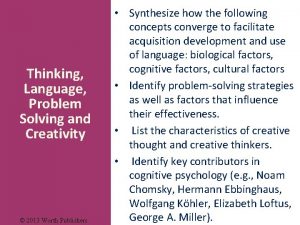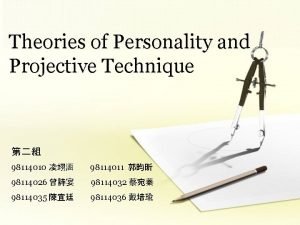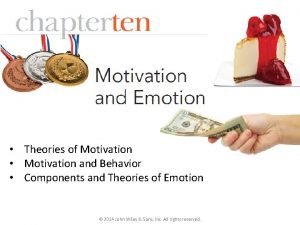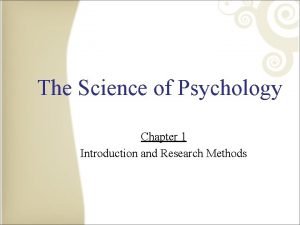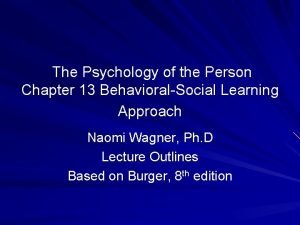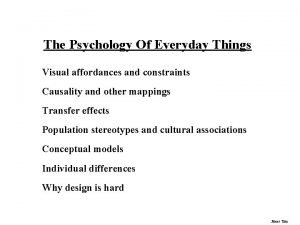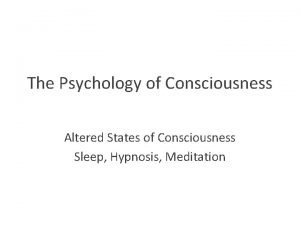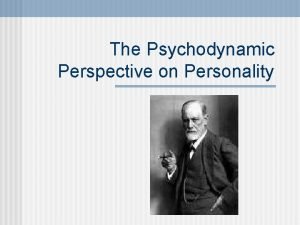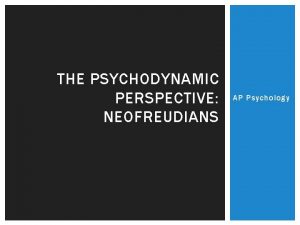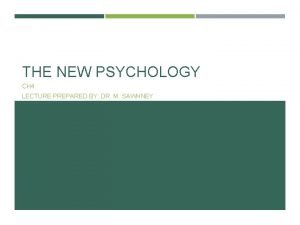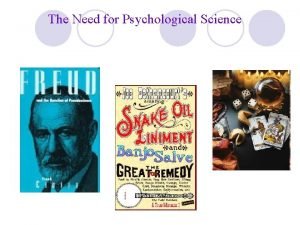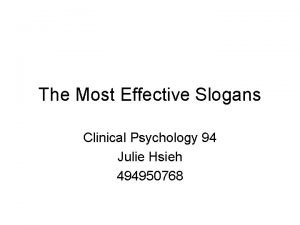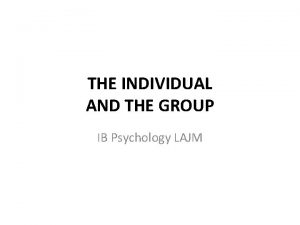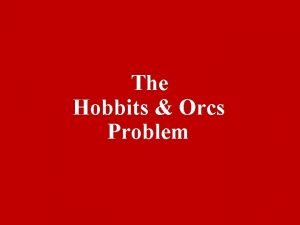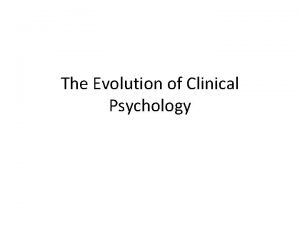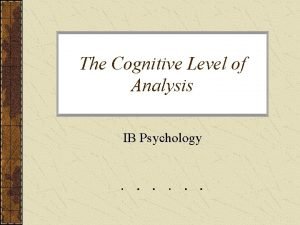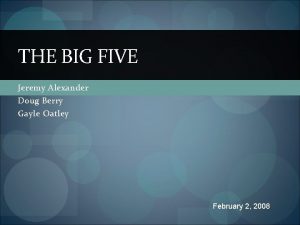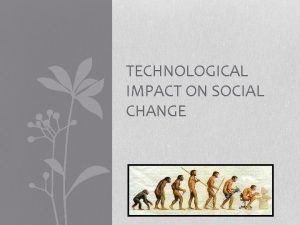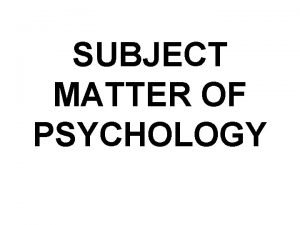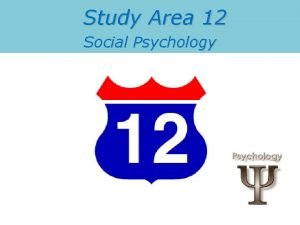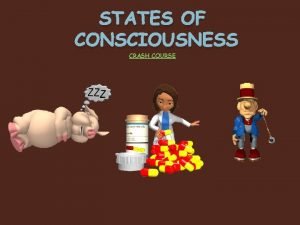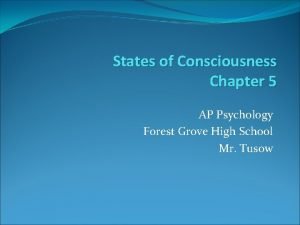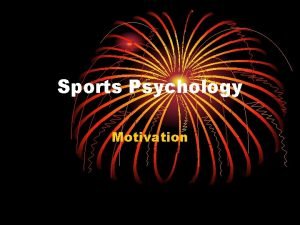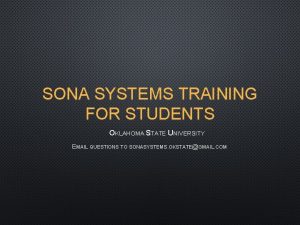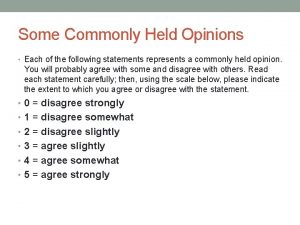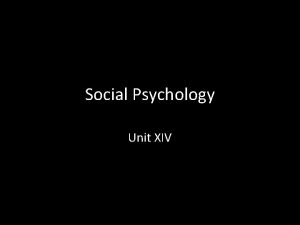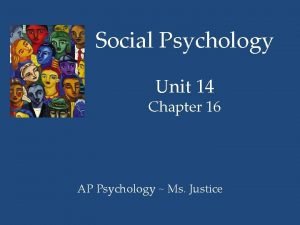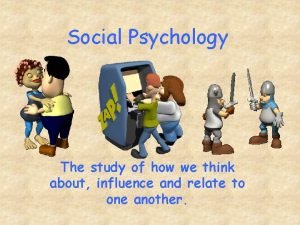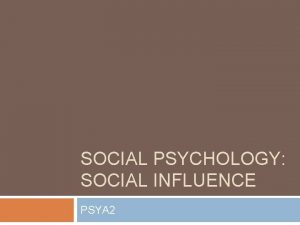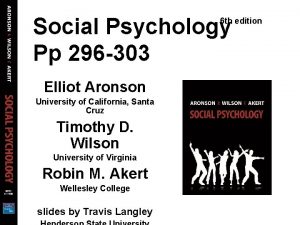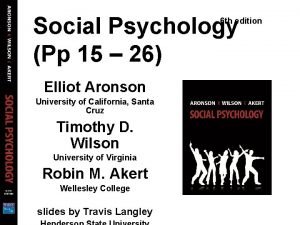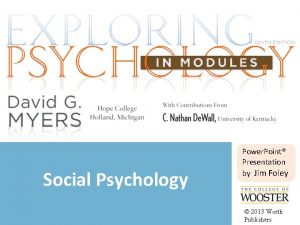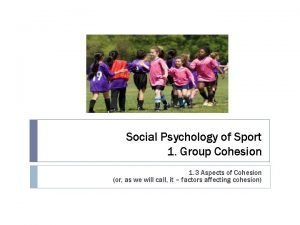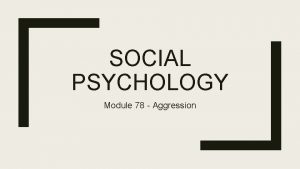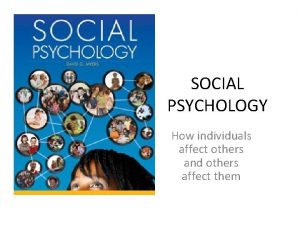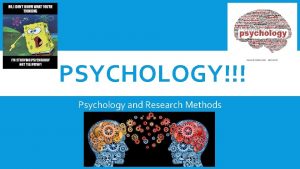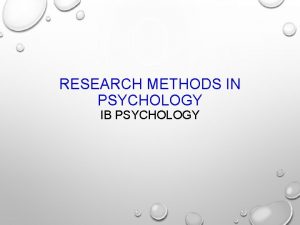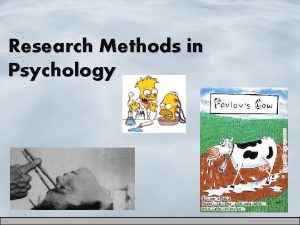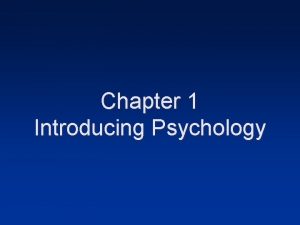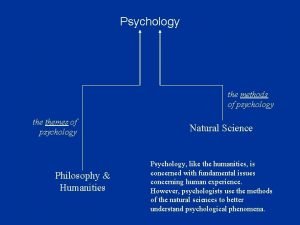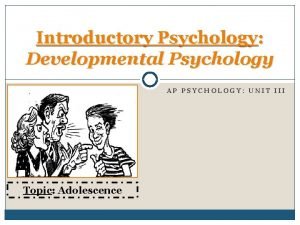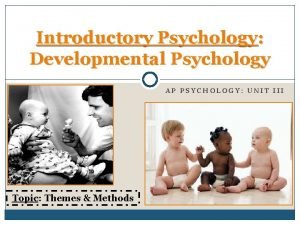Research in Psychology A P Psychology Ch 2





































































































































- Slides: 133

Research in Psychology A. P. Psychology Ch. 2

Practice Question #4 1. Which of the following most accurately describes a dependent variable? a. Some characteristic of research participants that is constant, such as gender b. Some aspect of a participant’s response that is measured in an experiment c. A factor that can be used to predict how people in an experiment will respond d. A factor that is manipulated by the experimenter in order to observe its effects on some other factor e. A factor that is equated for the experimental and the control group

How Do We Know What We Know? How do you know that George Washington was the first president of the United States?

How do we know what we know? How do you know that you really have a stomach?

How do we know what we know? What makes you so sure the sun will rise tomorrow?

How do we know what we know? How do you know the color of the shirt I’m wearing? Are you sure you don’t have a big hole in the back of your pants or shorts?

How do we know? Authority: historians, scientists Reason: deductive reasoning, inductive reasoning n n All humans have stomachs; I am human; therefore, I have a stomach The sun rose today, yesterday, and for as long as anyone can remember Observation: what you can see

MAN’S First Experiment If you could take a guess when (year) did the first documented psychological experiment take place?

First Psychological Experiment in History King Psamtik I of Egypt, in the latter half of the 7 th Century B. C. believed the Egyptians were the most ancient race. In order to prove that he took two infants and isolated them with a herdsman. They were not allowed to hear spoken language. Psamtik believed that if children had no opportunity to learn a language from older people around them, they would spontaneously speak the primal, inborn language of humankind, which he expected to be Egyptian. The experiment worked, in that the first word/noise they uttered was becos. This was the Phrygian word for bread, hence he was disappointed to know the Phrygians were the older race. Today we know that under conditions of isolation there is no innate language and that children who hear no speech, never speak. Yet we admire him for trying to prove his hypothesis and having the notion that thoughts arise in the mind through internal processes that can be investigated.

Music Experiment

Sum it up to. .

Scientific Method Ask a question, Hunch, Theory Form a Hypothesis (educated guess) Conduct an experiment Analyze the data Create conclusions


Theory n n Set of ideas which try to explain what we observe Goal is to find support OR disprove w. We can never prove!! w. How the world started (we might get close) Empirical n Knowledge based on direct observation

What are your theories? Write down at least 3 different theories or hunches you have about human behavior or human life n Ideas (get juices flowing) w Sleep w Drugs w Environment w gender w relationships

The Process of Doing Research Next, formulate a hypothesis n Hypothesis: specific statement of what you expect to happen (educated guess) w State the relationship between two variables w Risky prediction: falsifiability n Example: exposure to TV violence causes aggression

What are the variables? n n Variable: in an experiment, any factor that is measured or controlled and is capable of change Example: Exposure to TV violence causes aggression w Variable: TV violence w Variable: Aggression

Let’s take a closer look. . . at variables Independent variable (predictor variable) n n The factor being manipulated or changed The variable whose effect is being studied w TV Violence Dependent variable (outcome variable) n n The variable that may change in response to changes of the independent variable The factor that is being measured w Aggression


t n e d n e Dep e l b a i r Va Independent variable

Music Experiment What is the independent variable in our experiment? (change or be manipulated) What is the dependent variable in our experiment? (response or outcome)

Practice Question #4 1. Which of the following most accurately describes a dependent variable? a. Some characteristic of research participants that is constant, such as gender b. Some aspect of a participant’s response that is measured in an experiment c. A factor that can be used to predict how people in an experiment will respond d. A factor that is manipulated by the experimenter in order to observe its effects on some other factor e. A factor that is equated for the experimental and the control group

Practice Question #4 1. Which of the following most accurately describes a dependent variable? a. Some characteristic of research participants that is constant, such as gender b. Some aspect of a participant’s response that is measured in an experiment c. A factor that can be used to predict how people in an experiment will respond d. A factor that is manipulated by the experimenter in order to observe its effects on some other factor e. A factor that is equated for the experimental and the control group

Practice Question #6 1. Synesthesia is a phenomenon that has been estimated to occur in only a few people in a million. Because of its rarity, researchers are likely to choose which research method to study it? a. Naturalistic observation b. Correlational research c. Survey research d. Case study e. Experimental research

Due Date & Test Changes Vocabulary & Context due Sept. 11 (instead of Sept. 9 th) Ch. Test is Sept. 18 th instead of 16 th

Turn your Theories into Hypothesis Pick one of your Theories to Turn into A Hypothesis that has expresses a relationship between two variables. n Write down your hypothesis w You will be conducting your own experiment in the future so this is a good way to get started

The Process of Doing Research Then pick your research method n Case Studies, Correlational, Naturalistic Observation, & Experimental (Design) collect & analyze your data

Case Study Technique: one person or small group is studied in depth to reveal underlying behavioral principles. (up to 5 people) PROS: Provide detailed descriptive analyses of new, complex, or rare phenomena/disorders CONS: may not provide representative picture of phenomena, info often missing, can be hard to interpret, biases & (not able to generalize to larger population) Sigmund Freud used this technique! 28

Case Study Most commonly used by clinicians Sources of knowledge & insight Phenomenon's are researchers are likely to turn to choose case studies n ethics prevent them from information other ways https: //www. youtube. com/ watch? v=h. Xe. J 6 qnsd. D 4 Genie, the young girl who was locked up in her room since age 1 ½.

Correlational Method a researcher examines relationships among variables that are NOT manipulated by the researcher n n Positive or negative correlations Track trends & patterns Types of Correlational Methods n Surveys For example: researchers may study developmental changes, compare males and females, or look at the impact of disasters on the incidence of depression.




Positive correlation High values of one variable are associated w/ high values of another Low values of one variable are associated with low values of the other. n The presence of one thing predicts the presence of another



Negative Correlation High values of one variable are associated with low values of the other n the presence of one thing predicts the absence of another If no relationship exists then they are uncorrelated



Survey 1 -10 You are going to take a Survey. List your paper 1 -15 (ready) 1 Would you rather. . . n n Have a diet to heavy on grease A diet too heavy on sugar 2 Would you rather. . . n n Be trapped in a cave full of vampire bats Put a large jar full of bees (opened) in your pants 3 Would you rather. . . n n Have your house hit once every 6 months with graffiti vandals. Have your house hit once every two weeks with toilet paper vandals. 4 Would you rather. . . n n Have Xray vision Have the power to read minds 5 Would you rather. . . n n Wear the same pair of unwashed socks for 2 years Wear the same pair of unwashed underwear for 1 year

Survey 6 Would you rather. . . n n Have eyebrows that make a complete circle around your eyes Have flat eyelashes that stick out 12 inches and can't be trimmed 7 Would you rather. . . n n Get on the really good side of Bill Gates Or your favorite actor/actress 8 Would you rather. . . n n Do a job interview with your bottom lip 5 times it's size With a cat face painted on you 9 Would you rather. . . n n Never show up in photographs Have no reflection in mirrors? 10 Would you rather. . . n n (FOR THE SAME AMOUNT OF $) Have a job you love and work 60 hours a week Have a job you hate and work 25 hours a week

Theories What conclusions can you come up with after getting the results of the survey? What are the good things about survey’s? What are bad things about survey’s?

Survey Technique: self-reported attitudes, opinions or behaviors of people done by questioning a random sample of people. PROS: gathers large amounts of descriptive data relatively quickly and inexpensively, can see if a relationship between variables exist CONS: sampling errors, poorly phrased questions, response biases, volunteer bias, lying, assumptions in questions 43

Problems with Surveys Wording Effects Wording can change the results of a survey. Q: Should cigarette ads and pornography be allowed on television? (not allowed vs. forbidden) 44



Correlational research Advantages n n Sometimes manipulation of variables is impossible or unethical Efficient – look at lots of data Disadvantages n n CANNOT DETERMINE CAUSATION Could be a lurking variable that cannot be controlled like in a lab






Naturalistic Observation Observing and recording behavior in naturally occurring situations without trying to manipulate and control the situation Jane Goodall was famous for her naturalistic observation of chimpanzees in the wild PROS: Provides descriptive data, doesn’t intrude, normal social environments CONS: Observer bias and subject selfconsciousness can distort results 53


What are some natural environments?

What are some natural environments? Home Playground Park School Street Office Bar movies playing field restaurants sports area

Personal Space Next time you go to a public place where people seat themselves near others (movies, fast food, etc) Observe how many seats they leave between themselves and the next person. On average, how far do people tend to sit from strangers? Why do you think that is?

Observation experiment What are some theories you have about teachers, students, administration here at school? (lunch, passing period, after school, in class) Natural observation Assignment

Practice Question #5 1. Synesthesia is a phenomenon that has been estimated to occur in only a few people in a million. Because of its rarity, researchers are likely to choose which research method to study it? a. Naturalistic observation b. Correlational research c. Survey research d. Case study e. Experimental research

Practice Question #5 1. Synesthesia is a phenomenon that has been estimated to occur in only a few people in a million. Because of its rarity, researchers are likely to choose which research method to study it? a. Naturalistic observation b. Correlational research c. Survey research d. Case study e. Experimental research

Practice Question 1. Researchers find that there is a significant positive correlation between the number of hours students sleep and their grades. The researchers would be justified in concluding that a. Earning good grades causes people to sleep more b. Sleeping more causes students to perform better in school c. Students who earn good grades tend to sleep more than those who do not d. More sleep has beneficial impact on students’ grades e. Sleep deprivation has no impact on school performance

Practice Question 1. Researchers find that there is a significant positive correlation between the number of hours students sleep and their grades. The researchers would be justified in concluding that a. Earning good grades causes people to sleep more b. Sleeping more causes students to perform better in school c. Students who earn good grades tend to sleep more than those who do not d. More sleep has beneficial impact on students’ grades e. Sleep deprivation has no impact on school performance

Practice Question #7 1. Which of the following studies demonstrates a cross-sectional research design? a. Testing the first graders, and testing them again when they are in third grade b. Testing first graders at the end of the school year c. Testing first, third, and fifth graders at the beginning of the school year d. Observing first graders as they test in two different subjects e. Observing first graders as they interact with either third graders or fifth graders

Laboratory Observation Pros: Equipment, Clear line of vision, control Cons: presence of researchers & equipment can change behavior, not natural environment Hawthorne effect subjects modify/improve behavior b/c they are being observed


Do you agree or disagree & why?

Do plants grow better if you talk to them?

What’s Rice got to do with it?

What’s Rice got to do with it? Do you think words have an affect on rice? Why or why not? What theories do you have about Rice?

Experimental Research that manipulates one variable (IV) to see effect on other variable (DV) n Try to hold everything else constant

Design Differences Correlational Design a researcher examines relationships among variables that are NOT manipulated by the researcher n n Track trends & patterns For example: researchers may study developmental changes, compare males and females, or look at the impact of disasters on the incidence of depression. Experimental Design the researcher does manipulate or change some characteristic(s) of the situation & measures to determine the effects of the manipulation or change n For example: Manipulating or changing temperatures in a testing environment

True experiments have… Random sampling: selecting participants randomly from population (and a lot of them! The bigger the sample —the better!) n Representative Sampling: the sample can represent the population you’re testing n w Example: How tall is the average male in Illinois? Should I include the b-ball players from the Chicago Bulls? ? Is that representative?

Operational Definitions Experiments need to have precise operational definitions n Specify how the phenomena in question are to be observed and measured. w Experiment on Anxiety- How are you going to measure anxiety? w Experiment on are you right handed or left handed? (is this an operational definition? Approx. 90% of population is right-handed Does it need to be more specific? Are you as strongly right- or left-handed as you think? Let’s see!

Finding the outcome The hand with the higher score is defined as the dominant hand Compare the two measures. Are they consistent b/w the two? Which test gives a more accurate assessment of their handedness? One is a self-report questionnaire Other is a skilled performance (Dependent variable)


Experimental Group: the group to which an independent variable is applied Control Group: the group that is treated in the same way as the experimental group EXCEPT that the independent variable is not applied n You NEED to know behavior wouldn’t have happened without your manipulation

l o r nt Co Manipulate



Example Do students get better test grades in classrooms with a higher temperature or lower temperature? Dependent Variable? Independent Variable? Control Group? Experimental Group(s)?

Example Do students get better test grades in classrooms with a higher temperature or lower temperature? Dependent Variable? grades Independent Variable? temperature Control Group? Middle temperature Experimental Group(s)? High temp Low temp

Example Does playing violent video games cause violence in teenagers? Dependent Variable? Independent Variable? Control Group? Experimental Group(s)?

Types of Studies: Longitudinal Study: a study conducted on participants over a long period of time (months, years) Pros: better data because of how long you study the participants Cons: some participants could back out after a while, or die Example: Tracking IQ scores of children who were breastfed as infants compared to children who were not breastfed as infants.

Types of Studies: Cross-Sectional study: a study conducted on participants of different age groups Pros: better comparative data between different age groups Cons: Age is the main factor measured, even though the participants may be reacting because of other variables Example: Researchers study which age groups watch which T. V. shows to determine what products to advertise during commercial breaks.

Practice Question #7 1. Which of the following studies demonstrates a cross-sectional research design? a. Testing the first graders, and testing them again when they are in third grade b. Testing first graders at the end of the school year c. Testing first, third, and fifth graders at the beginning of the school year d. Observing first graders as they test in two different subjects e. Observing first graders as they interact with either third graders or fifth graders

Practice Question #7 1. Which of the following studies demonstrates a cross-sectional research design? a. Testing the first graders, and testing them again when they are in third grade b. Testing first graders at the end of the school year c. Testing first, third, and fifth graders at the beginning of the school year d. Observing first graders as they test in two different subjects e. Observing first graders as they interact with either third graders or fifth graders

Practice Question 1. A disadvantage of longitudinal studies is that a. Differences observed among participants of different ages are usually due to differences in environment in which they were reared b. Participants who drop out during the course of the study may be different in important ways from ones who do not drop out c. Unfamiliarity with testing situations can put older participants at a disadvantage d. Personality traits do not remain constant across the life span e. Men and women confront different developmental crises in the course of their lives because of their different social roles

Practice Question 1. A disadvantage of longitudinal studies is that a. Differences observed among participants of different ages are usually due to differences in environment in which they were reared b. Participants who drop out during the course of the study may be different in important ways from ones who do not drop out c. Unfamiliarity with testing situations can put older participants at a disadvantage d. Personality traits do not remain constant across the life span e. Men and women confront different developmental crises in the course of their lives because of their different social roles



Practice question #8 1. A double-blind control is essential for which of the following? a. A study comparing the IQ test scores of children from different educational systems. b. A study of relationships among family members c. An experiment to determine the effect of a food reward on the bar-pressing rate of a rat d. Assessment of a treatment designed to reduce schizophrenic symptoms e. A survey of drug use among teenagers

Things to Watch out for when conducting an experiment Placebo effect Hindsight bias Confirmation Bias Ethics

I r t s i ? l ea ? ?

True or False Quiz 1. Animals experience the placebo effect. 2. You cannot fake being drunk 3. Location makes a difference when it comes to thinking a medicine will work. 4. Placebos don’t work when it comes to depression 5. The placebo still works when you know it is a placebo

Placebo Effect An effect or behavior caused by your beliefs and expectations as opposed to something external An effect or behavior caused by a substance or condition which the recipient assumes is working Example: Participant takes a pill assuming it will relieve their headache. Their headache does go away, but the pill they took was a sugar pill. The IDEA of the pill helped them recover! That’s the placebo effect!

Placebo You are to go around the room and find the answers to your quiz n Fill out the chart/organizer as you go around the room

10 Crazy Facts About the Placebo Effect The Placebo Effect is one of the strangest and least understood phenomenon’s found in human physiology & psychology. n n namely that we can essentially cure ourselves of maladies simply because we believe we are being cured of them. In other words we trick ourselves back into health, proving that the brain is an extremely powerful entity.

The Placebo Effect http: //listverse. com/2013/02/16/10 crazy-facts-about-the-placebo-effect/ Henry and Noreen go on a date (50 first dates) https: //www. youtube. com/watch? v=yf. R VCa. A 5 o 18

Did you just know?

What to watch out for. . Hindsight Bias: The tendency to believe, after learning the outcome, that you knew it all along.

What to watch out for… Confirmation bias: a tendency to search for or interpret information in a way that confirms one's preconceptions, leading to statistical errors.

What to watch out for… Self-fulfilling prophecy: a prediction that directly/indirectly causes itself to become true, by the very terms of the prophecy itself

Overconfidence We tend to think we know more than we do! 82% of U. S. drivers consider themselves to be in the top 30% of their group in terms of safety 81% of new business owners felt they had an excellent chance of their businesses succeeding. When asked about the success of their peers, the answer was only 39%.

How do you eliminate expectations and influence in studies? Consider both the researcher and participant

Experimenter Effects Single-Blind Study Participants don’t know whether they are the experimental or control group Double-blind Study Participants don’t know whether they are the experimental or control group Experimenter: Doesn’t know which subjects are in which groups until data has been gathered

Double-blind Procedure - Double blind essential in evaluating drug therapies - Assistants should remain unaware of which patients had the real treatment and which should have the placebo 106


Ethics in Experiments

Ethics in Research Should the study be done? n n Value vs. potential cost APA guidelines (American Psychological Association) How do we protect Participants? n n n Informed consent Confidentiality & anonymity Debriefing No long lasting physical/psychological harm Ability to withdraw at any time

Debriefing Can mislead participants for experiment purposes (don’t give the experiment away) n n Researchers need to show any deceptive procedures are justified by a study’s potential value Thorough debriefing about true purpose

15 Principles of Ethics Review principles of ethics You are to get in a group of 2 and you have to convince the class your ethic that is assigned is the most important ethically regarding experiments n Give example scenarios

Animal Testing: Do you believe we should use animals for testing? Why or why not? (3 -5 sentences)

Animal Testing Facts Listen to the quotes said by your classmates on Animal testing At the end, after all is said and done are you still for or against animal testing? 35 sentences explaining your reasoning

APA & Animals Humane treatment of animals Federal laws for housing and care of animals 8. 09 guideline for Humane Care and Use of Animals in Research

Practice Question 1. Which of the following best describes the response of members of American Psychological Association to ethical issues in research? a. They have just begun to address such issues. b. They disclaim ethical concerns regarding research. c. They have developed codes of ethics for research with animal subjects only. d. They have developed codes of ethics for research with both human participants and animal subjects.

Practice question #8 1. A double-blind control is essential for which of the following? a. A study comparing the IQ test scores of children from different educational systems. b. A study of relationships among family members c. An experiment to determine the effect of a food reward on the bar-pressing rate of a rat d. Assessment of a treatment designed to reduce schizophrenic symptoms e. A survey of drug use among teenagers

Practice question #8 1. A double-blind control is essential for which of the following? a. A study comparing the IQ test scores of children from different educational systems. b. A study of relationships among family members c. An experiment to determine the effect of a food reward on the bar-pressing rate of a rat d. Assessment of a treatment designed to reduce schizophrenic symptoms e. A survey of drug use among teenagers

Practice Question #9 1. A test is administered to 1, 000 fourth graders across the county, and then it is readministered to the same children 90 days later. The test-retest results will yield an evaluation of the test’s a. Validity b. Reliability c. Cross-cultural fairness d. Factor analysis e. Good of fit

Psychological tests Objective (aware) vs. Projective (not aware) Standardized- Uniform procedures for administering tests and collecting scores n What are ways tests are standardized? Reliable- same results @ different times & places w Test-retest reliability w Alternate-forms reliability Validity- measure what its suppose to w Content validity w Criterion validity- predict independent measures of the trait in question

Projective Test (what do you see? Write it down)

Objective Test http: //www. humanmetrics. com/cgiwin/jtypes 2. asp

Are tests Reliable? Test-Retest reliability The administration of the same test to subjects two or more times (under similar conditions) n Scores are correlated Alternate-forms reliability Parallel or alternate forms of a test are administered to the same individuals n n Scores are correlated When a researcher believes that repeated administration of test will result in “testwiseness” they will give an alternate form (prevent cheating)

Are tests Valid: Measure what its suppose to? Content Validity: assessment content appropriate to what is suppose to be measured n Does test reflect knowledge/skills required to do demonstrate one’s grasp of course material Criterion Validity: Assessment scores of participants are related to a criterion outcome measure (predicts future or past) n Does the SAT & ACT scores predict postsecondary performance(how well you will do in college)?

Correlations: Coefficient of correlation Number conveys size/strength of correlation & if + or – Perfect Positive Correlation is +1. 00 Perfect Negative Correlation is – 1. 00 If no association then coefficient is 0

Evaluating Findings 1. Describe them 2. Assess how reliable & meaningful they are 3. How do you explain findings? n n Descriptive Statistics Inferential Statistics

Descriptive Statistics Measurement of data Arithmetic Mean What happened to the group as a whole Summarizes group averages (compares) control vs experimental group) n Does not tell us variability of subjects responses Standard Deviation How clustered or spread out scores are around the mean n Spread out = less typical (the average isn’t typical

Standard Deviation How do you find the Standard Deviation? 1. Work out the Mean (simple average of the numbers) 2. Then for each number subtract the mean and square the result Then work out the mean of those squared differences Take the square root of that and your done!

Inferential statistics How meaningful are the findings (inferences) n Inferring population parameters based on samples of data (generalize) w Parameter: a measurable characteristic of a population n Probability Give Statistically significant results of experiment

Place your Bets!!!

What the dice? Each person is going to roll the dice and add them together Everyone is to record the score & Frequency of getting that score Make a frequency distribution table (score/frequency)

Graphing Variables the dependent variable and is sometimes referred to as function (y). the independent variable which can be changed is sometimes referred to as function (x)

Bell Curve & Dice graph these frequency distributions, using the x axis for the score and the y axis for the frequency. Why does the data turn out that way? What other data might look like this? Find the standard deviation of our results

Quick Quiz: Descriptive (d) or Inferential (I) 1. Summarize the data 2. Give likelihood of data occurring by chance 3. Include the mean 4. Give measure of statistical significance 5. Tell you whether to call your mother about your results
 Positive psychology ap psychology definition
Positive psychology ap psychology definition Group think vs group polarization
Group think vs group polarization Fundamental attribution error ap psychology
Fundamental attribution error ap psychology Introspection method in psychology
Introspection method in psychology Social psychology is the scientific study of
Social psychology is the scientific study of Health psychology definition ap psychology
Health psychology definition ap psychology Correlational research psychology
Correlational research psychology Methods of social psychology
Methods of social psychology Experimental method of psychology
Experimental method of psychology Research methods in developmental psychology
Research methods in developmental psychology Research design in clinical psychology
Research design in clinical psychology Market research psychology
Market research psychology Sential
Sential Experimental psychology research topics
Experimental psychology research topics Socially sensitive research meaning
Socially sensitive research meaning Research methods in abnormal psychology
Research methods in abnormal psychology Ocr psychology research methods
Ocr psychology research methods Module 7 research design and ethics in psychology
Module 7 research design and ethics in psychology Research related subfields in psychology
Research related subfields in psychology Chapter 2 the research enterprise in psychology
Chapter 2 the research enterprise in psychology Chapter 2 critical thinking answers
Chapter 2 critical thinking answers Factorial research design in psychology
Factorial research design in psychology Research enterprise in psychology
Research enterprise in psychology Research report vs research proposal
Research report vs research proposal Methods versus methodology
Methods versus methodology Quantitative research examples
Quantitative research examples Differences between exploratory and conclusive research
Differences between exploratory and conclusive research Define pure research
Define pure research Qualitative research design
Qualitative research design Contrast applied research and basic research
Contrast applied research and basic research Meaning of research problem
Meaning of research problem Research instrument in experimental research
Research instrument in experimental research Longitudinal research and cross sectional research
Longitudinal research and cross sectional research Correlational vs comparative
Correlational vs comparative How to write research methodology chapter 3
How to write research methodology chapter 3 Example of applied research
Example of applied research Bryman bell
Bryman bell Reseach
Reseach Qualitative research research design
Qualitative research research design Inquiry in practical research 2
Inquiry in practical research 2 Conclusive research design
Conclusive research design Exploratory research types
Exploratory research types Purpose of the study in research proposal example
Purpose of the study in research proposal example Research instrument in experimental research
Research instrument in experimental research Purpose of qualitative research
Purpose of qualitative research What is a working model psychology
What is a working model psychology Parents impose rules and expect obedience
Parents impose rules and expect obedience Initiative vs guilt
Initiative vs guilt Practical intelligence ap psychology
Practical intelligence ap psychology Unit 7 cognition ap psychology
Unit 7 cognition ap psychology Mentalset
Mentalset Ap psych behaviorism
Ap psych behaviorism Color constancy ap psychology
Color constancy ap psychology Ethnocentrism ap psychology
Ethnocentrism ap psychology Unit 10 ap psychology
Unit 10 ap psychology Minnesota multiphasic personality inventory
Minnesota multiphasic personality inventory Two factor theory psychology
Two factor theory psychology Drive-reduction theory
Drive-reduction theory Optimistic explanatory style ap psychology
Optimistic explanatory style ap psychology Social inhibitoon
Social inhibitoon The word psychology comes from
The word psychology comes from Psychological perspective
Psychological perspective Gestalt theory
Gestalt theory Types of child psychology
Types of child psychology Conjunction fallacy psychology
Conjunction fallacy psychology Ap psychology chapter 14
Ap psychology chapter 14 Define personality and its determinants
Define personality and its determinants Social psychology examples
Social psychology examples Advantages of case studies in psychology
Advantages of case studies in psychology Perceptual set psychology definition
Perceptual set psychology definition Module 9 gestalt psychology
Module 9 gestalt psychology Psychology unit 4 aos 2
Psychology unit 4 aos 2 Psychology study design vcaa
Psychology study design vcaa Five difference between guidance and counselling
Five difference between guidance and counselling Informational social influence
Informational social influence The 7 approaches to psychology
The 7 approaches to psychology How did wilhelm wundt break down consciousness
How did wilhelm wundt break down consciousness Explain command term ib psychology
Explain command term ib psychology Trait perspective psychology
Trait perspective psychology Lawrence kohlberg developmental psychology
Lawrence kohlberg developmental psychology Social cognitive theory
Social cognitive theory Structuralism vs functionalism
Structuralism vs functionalism Example of cognitive dissonance
Example of cognitive dissonance Cognition refers to
Cognition refers to How to solve the 9 dot puzzle
How to solve the 9 dot puzzle Eclectic psychology
Eclectic psychology Senior apperception test in psychology ppt
Senior apperception test in psychology ppt Regression psychology
Regression psychology Optimal arousal theory
Optimal arousal theory Developmental stage theories
Developmental stage theories Interpersonal intelligens
Interpersonal intelligens Operational definition examples behavior
Operational definition examples behavior Reciprocal determinism psychology definition
Reciprocal determinism psychology definition Psychology of everyday things
Psychology of everyday things Altered state of consciousness psychology
Altered state of consciousness psychology Introjection example defense mechanism
Introjection example defense mechanism Psychodynamic ap psychology
Psychodynamic ap psychology The id operates on the ________ principle.
The id operates on the ________ principle. Father of psychology
Father of psychology Examples of naturalistic observation
Examples of naturalistic observation Julie sloggan
Julie sloggan Loose thought process
Loose thought process Hamilton and gifford 1976 ib psychology
Hamilton and gifford 1976 ib psychology Orc and hobbit problem
Orc and hobbit problem Humanistic disciplines
Humanistic disciplines Nature of clinical psychology
Nature of clinical psychology Flashbulb memory ib psychology
Flashbulb memory ib psychology Freed et al (2001 ib psychology)
Freed et al (2001 ib psychology) Diathesis stress model
Diathesis stress model Big 5 in psychology
Big 5 in psychology Apa format without title page
Apa format without title page Technology as an agent of change
Technology as an agent of change What is the subject matter of psychology
What is the subject matter of psychology Bandura's reciprocal determinism
Bandura's reciprocal determinism Deindividuation example
Deindividuation example Structuralist narratology
Structuralist narratology Crash course states of consciousness
Crash course states of consciousness Alpha waves ap psychology
Alpha waves ap psychology Drive theory of social facilitation
Drive theory of social facilitation Motivation psychology definition
Motivation psychology definition Okstate sona
Okstate sona Hand mnemonic for the 7 perspectives of psychology
Hand mnemonic for the 7 perspectives of psychology Unit xiv social psychology
Unit xiv social psychology Frustration aggression principle
Frustration aggression principle Door in the face technique
Door in the face technique Psychology is a broad field
Psychology is a broad field Conformity psychology
Conformity psychology Realistic conflict theory
Realistic conflict theory Gestalt psychology founder
Gestalt psychology founder Social psychology presentation
Social psychology presentation Factors affecting cohesion in sport
Factors affecting cohesion in sport Module 79 ap psychology
Module 79 ap psychology Social psychology lecture
Social psychology lecture Social psychology vs sociology
Social psychology vs sociology






